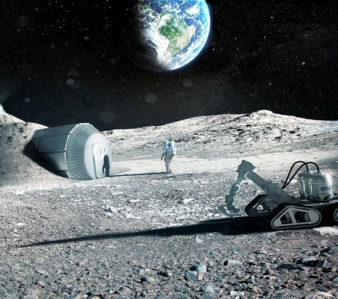29/01/2019 — auf Deutsch lesen
Spinning machine in outer space
Spinning moon rock on site into the finest, high-strength textile fibres.
Whilst chatting over a beer at their local pub, the two Aachen-based scientists Alexander Lüking and Thilo Becker started discussing an idea – an idea that could give technical textiles a lunar perspective. Just a few months after the notable drinking session, Prof. Dr. Thomas Gries, head of the Institute for Textile Technology (ITA) at RWTH Aachen University, assembled several journalists to shed light on the astounding progress this idea has made since its humble beginnings. The new ITA approach to the on-site melt spinning of moon rock into the finest, high-strength textile fibres is currently being widely discussed in German aerospace circles. In addition, the researchers have already secured several sponsors to build the prototype and demonstration model of an “iBoss” spinning machine for ESA, NASA and the like.
Spinning moon rock on site into the finest, high-strength textile fibres
Back to the distant moon and the unavoidable fact that every kilogram of material needed to build a moon station has to be rocketed into space by the Americans, Chinese or Russians, absorbing huge sums of money. MoonFibre, as the project is known, could slash costs by using the moon’s own resources and, as a complement to 3D printing concepts for utilising moon rock, could enable Astronauts, Taikonauts and Cosmonauts to live in fibre-reinforced, impact-protected bases.
“What comes out of a 3D printer is not mechanically stable enough to provide sufficient protection to the crew and the installations on the moon,” states the Institute of Structural Mechanics and Lightweight Design, which is also involved in the project.
How could moon textiles be made?
With sophisticated technology and solar energy in an autarkic box. The experimental cube is expected to undergo the zero-gravity test at the ISS as soon as possible. It is likely to cost EUR 300,000, which is to be funded from donations of EUR 15,000 at a time. “We’ve already found ten partners,” states a confident Prof. Gries. The main steps taking place inside the box include: Crushing the moon rock into cubes that are about as thick as a finger, melting them at around 1,200 degrees, and spinning them into wafer-thin fibres with the help of a platinum jet system.
Using conventional technology, the ITA is currently running spinning trials with basalt, which closely corresponds to the “Highlands” basalt type found on the moon. The medium-term aim is to have four scientists, three technicians and a laboratory assistant working on the project over a period of five years. One of their tasks will involve spinning basalt fibres under microgravity with a view to predicting spinning behaviour on the moon.
NASA is planning its next manned mission to the moon in 2022. The moon is rich in raw materials such as Helium-3 and lends itself as a stepping stone for the exploration of Mars. Having entered this field through the back door, the ITA will be involved right from the start.




